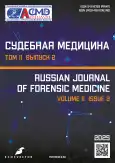关于选择用于热力学方法推断死后间隔时间的温度测量仪器精度问题
- 作者: Vavilov A.Y.1, Khalikov A.A.2, Naidenova T.V.2
-
隶属关系:
- Bashkir State Medical University
- Izhevsk State Medical Academy
- 期: 卷 11, 编号 2 (2025)
- 页面: 137-144
- 栏目: 技术报告
- URL: https://bakhtiniada.ru/2411-8729/article/view/313914
- DOI: https://doi.org/10.17816/fm16250
- EDN: https://elibrary.ru/CQYNFL
- ID: 313914
如何引用文章
全文:
详细
论证: 尽可能准确地确定人的死后间隔时间对于客观调查危害生命的犯罪案件具有重要意义。众所周知,任何基于计算的方法都可能受到参数测量误差的影响,而仪器误差是其中的重要来源。然而,在热测法推断死后间隔时间的过程中,尚未确定何种温度测量精度在法医学鉴定实践中可视为令人满意。
目的:基于分析尸体及环境温度测量精度对计算推断死后间隔时间误差的影响,提出关于选择测温仪器的实用建议,供法医学尸检工作参考。
方法:采用C. Henssge等人提出的现象学数学模型,模拟在不同诊断区域(大脑、肝脏、直肠)及两种环境温度0°C和20°C条件下的尸体温度变化过程。在上述条件下,计算该方法在测温精度为1°C、0.1°C和0.01°C时的仪器误差值。所得误差以绝对值和相对值(%)表示,后者为误差值与其对应的死后间隔时间的比值。
结果:结果显示,尸体冷却早期及尸体温度趋近环境温度阶段的相对误差最大。在所有模拟条件下,使用测温精度为1°C的温度计时,相对误差均超过死后间隔时间估值的15%。 此外,使用测温误差为0.1°C和0.01°C的仪器,可在整个模拟时间段(2–24小时)内将相对仪器误差控制在不超过5%。
结论:从医学与生物学研究的标准要求来看,只有在尸体与环境温度的测量精度达到0.1°C或0.01°C时,才有可能获得令人满意的推断结果。为便于实际应用,我们将死后间隔时间仪器误差的计算算法实现为Microsoft Excel电子表格形式。
作者简介
Alexey Yu. Vavilov
Bashkir State Medical University
Email: izhsudmed@hotmail.com
ORCID iD: 0000-0002-9472-7264
SPIN 代码: 3275-3730
MD, Dr. Sci. (Medicine), Professor
俄罗斯联邦, UfaAirat A. Khalikov
Izhevsk State Medical Academy
编辑信件的主要联系方式.
Email: airat.expert@mail.ru
ORCID iD: 0000-0003-1045-5677
SPIN 代码: 1895-7300
MD, Dr. Sci. (Medicine), Professor
俄罗斯联邦, IzhevskTatiana V. Naidenova
Izhevsk State Medical Academy
Email: abhasvar@mail.ru
ORCID iD: 0000-0001-7847-4706
SPIN 代码: 7697-5731
MD, Cand. Sci. (Medicine)
俄罗斯联邦, Izhevks参考
- Viter VI, Vavilov AYu, Babushkina KA. The work procedure of a doctor-forensic expert when examining a corpse at the place of its discovery: a training manual. Izhevsk: Izhevsk State Medical Academy; 2016. Available from: https://www.forens-med.ru/book.php?id=4580 (In Russ).
- Novikov PI, Shved EF, Natsentov EO, et al. Modeling of processes in forensic medical diagnostics of the prescription of death. Chelyabinsk, Izhevs: Ural State Medical Academy of Continuing Education; 2008. (In Russ.) ISBN: 978-5-91385-041-6 EDN: XSFSVT
- Novikov PI. Determination of the Optimal Zone for Measuring the Body Temperature of a Corpse to Establish the Duration of Death. Forensic Medical Expertise. 1986;29(1):11–14. (In Russ.)
- Henssge C, Madea B. Estimation of the Time Since Death. Forensic Sci Int. 2007;165(2-3):182–184. doi: 10.1016/j.forsciint.2006.05.017
- Kulikov VA, Vavilov AYu. Software and hardware implementation of a thermometric method for diagnosing how long ago a person died (for forensic and forensic practice). In: Proceedings of the International Scientific and Practical Conference “Current issues of law and law enforcement at the present stage”. Krasnodar: Izdat. dom – Jug; 2013. P. 235–240. Available from: https://lawlibrary.ru/article2315301.html?ysclid=mda3tg6guz118933101 (In Russ.)
- Shved EF, Novikov PI, Vlasov AYu. Implementation on a Microcomputer of an Adaptive Method for Modeling the Process of Changing the Temperature of a Corpse. Forensic Medical Expertise. 1989;32(2):4–6. (In Russ.)
- Kulikov VA, Vavilov AYu. Forensic Examiner's Device. Medicinskaja jekspertiza i pravo. 2013;(6):59–61. (In Russ.) EDN: ROQDVN
- Glanz SA. Primer of Biostatistics. Buzikashvili NE, Samoilova DV, editors. Moscow: Praktika; 1999. Available from: https://medstatistic.ru/articles/glantz.pdf (In Russ.)
- Vavilov AYu., Khalikov AA, Shchepochkin OV, et al. On the error of the Thermometric Method for Determining the Age of Death. Problemy ekspertizy v meditsine. 2004;4(3):16–17. (In Russ.) EDN: MYVSSR
- Henssge C, Knight B, Krompecher Th, et al. The estimation of the time since death in the early postmortem period. 2nd edition. London: Hodder Arnold; 2002.
- Kildyushov ЕМ, Vavilov АYu, Kulikov VА. Diagnosis of Time of Death Using Thermometric Method in Early Postmortal Period (New Medical Technology). Vestnik sudebnoy meditsiny. 2012;1(1):19–23. EDN: PIVYGP
补充文件









